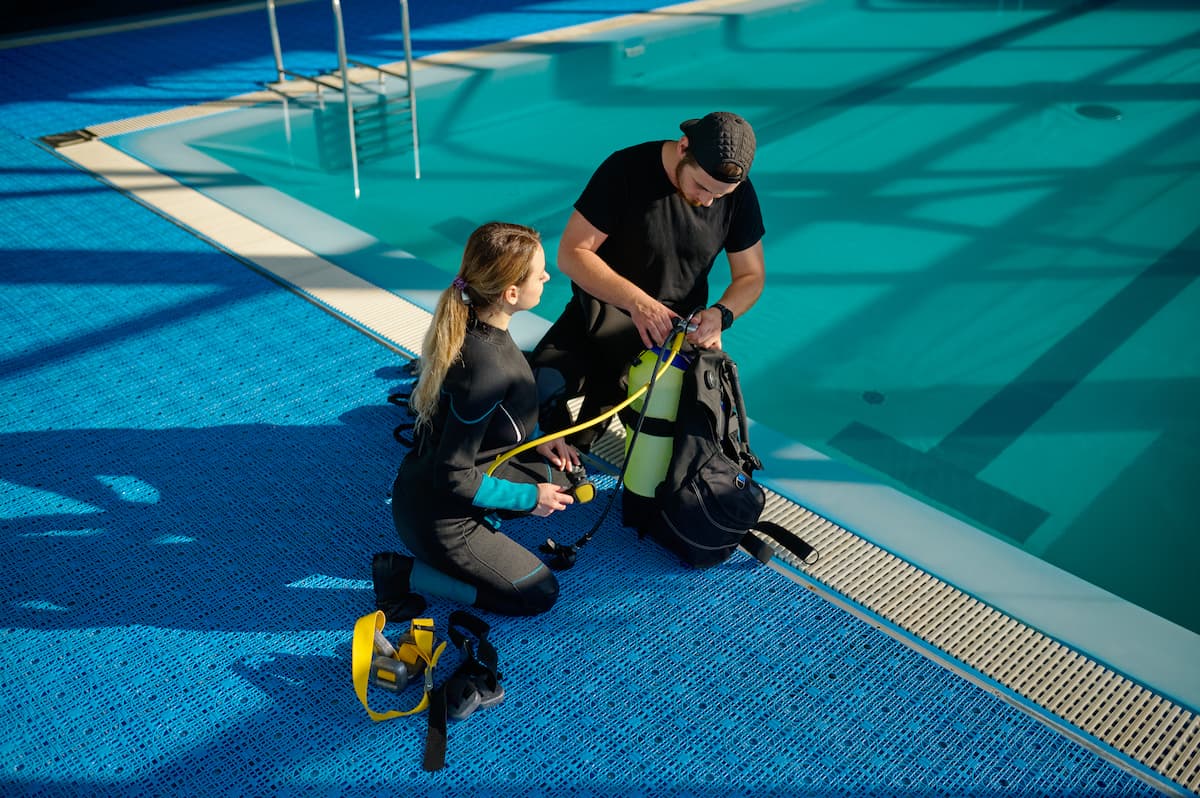Investing in scuba gear is essential for every diver, but maintaining that gear is equally crucial.
Proper care and maintenance can significantly extend the life of your equipment, ensuring it remains safe and functional for many dives to come.
This guide provides top tips for keeping your scuba gear in top shape, from regular cleaning to storage practices.
Each piece of equipment plays a critical role in your diving experience, and neglecting maintenance can lead to malfunctions or even accidents underwater.
By adopting regular care routines and being proactive about servicing, you can protect your investment and enjoy worry-free diving.
Importance of gear maintenance
Regular maintenance prevents corrosion, wear, and damage that can compromise the functionality of your equipment.
It also helps you identify and address potential issues before they become serious problems. Consistent care not only extends the life of your gear but also enhances your overall diving experience by ensuring everything operates smoothly.
YOU CAN ALSO READ: The role of technology in modern diving
Daily care and cleaning of scuba gear
Cleaning your scuba gear after each dive is the most basic yet essential step in maintaining it.
Saltwater, sand, and other debris can cause significant damage if not properly removed.
Rinsing your gear
After every dive, rinse your gear thoroughly with fresh water.
Pay special attention to areas where salt and sand can accumulate, such as zippers, seams, and buckles. Use lukewarm water and gently shake the gear to dislodge any particles.
Drying your gear
Allow your gear to air dry in a shaded area away from direct sunlight, which can cause fading and material degradation.
Hang items like wetsuits and BCDs on wide hangers to maintain their shape.
Ensure all equipment is completely dry before storing to prevent mold and mildew growth.
Cleaning products
Use mild detergents or specialized cleaning products designed for scuba gear.
Avoid harsh chemicals that can damage materials.
Regularly clean items such as masks, snorkels, and mouthpieces with antibacterial soap to prevent bacteria buildup.
Proper storage techniques
Proper storage is key to maintaining the integrity of your scuba gear.
Store your equipment in a cool, dry place away from direct sunlight and extreme temperatures.
Storing your wetsuit and drysuit
Hang wetsuits and drysuits on wide, padded hangers to avoid creasing and stress on the material.
Ensure they are completely dry before storing. For long-term storage, consider folding them loosely and placing them in a breathable storage bag.
Storing your BCD
Partially inflate your BCD before storing to maintain its shape and prevent the bladder from sticking together. Hang it in a cool, dry place using a sturdy hanger.
Avoid storing it near chemicals or sharp objects that could cause damage.
Storing your regulator
Store your regulator in a padded bag to protect it from impact and dust. Ensure the hoses are loosely coiled and not under tension. Keep the dust cap on to prevent debris from entering the first stage.
Regular maintenance and servicing
In addition to daily care, your scuba gear requires periodic maintenance and professional servicing to ensure it remains in optimal condition.
Annual servicing
Most manufacturers recommend annual servicing for regulators, BCDs, and dive computers. This servicing includes inspecting, cleaning, and replacing worn parts. Adhering to this schedule ensures your gear functions correctly and extends its lifespan.
Pre-dive checks
Conduct pre-dive checks before each dive to identify any issues. Inspect hoses, seals, and connections for signs of wear or damage. Test your BCD’s inflator and deflator mechanisms, and check your regulator for smooth airflow.
YOU CAN ALSO READ: Scuba Diving Trips: Planning the Perfect Adventure
Specific care tips for each piece of equipment
Each piece of scuba gear has unique maintenance needs.
Here are detailed care tips for some of the most critical items.
Mask, snorkel, and fins
Mask
- Cleaning: clean your mask with a gentle, non-abrasive cleaner to remove salt and oils. Avoid touching the inner lens to prevent scratches.
- Storage: store your mask in a protective case to avoid scratches and deformation.
Snorkel
- Rinsing: rinse your snorkel thoroughly with fresh water after each dive to remove salt and debris.
- Cleaning: use antibacterial soap to clean the mouthpiece regularly.
Fins
- Rinsing: rinse fins with fresh water, especially around the foot pockets and straps.
- Storage: store fins flat or in a hanging position to prevent warping.
Wetsuit and drysuit
Wetsuit
- Rinsing: rinse your wetsuit thoroughly with fresh water after each use, both inside and out.
- Drying: hang to dry in a shaded, well-ventilated area.
- Storage: store on a wide hanger to maintain shape and prevent creasing.
Drysuit
- Zipper care: keep the zipper clean and lubricated to ensure smooth operation.
- Seal maintenance: regularly inspect and clean the seals, and apply talc powder to keep them supple.
- Storage: store flat or hanging, with zippers open to prevent stress on the material.
Buoyancy Control Device (BCD)
- Rinsing: rinse both the inside and outside of your BCD. Inflate it slightly and rinse through the inflator hose.
- Drying: hang the BCD to dry in a shaded area, ensuring all internal water is expelled.
- Storage: store partially inflated to maintain shape and avoid bladder adhesion.
Regulator
- Rinsing: rinse your regulator thoroughly with fresh water, ensuring the dust cap is in place to prevent water from entering the first stage.
- Cleaning: soak in lukewarm water to dissolve salt crystals. Pay attention to the mouthpiece and second stage.
- Storage: store in a padded bag to protect from impact and contamination.
Dive Computer
- Rinsing: rinse your dive computer with fresh water after each dive.
- Battery: monitor battery levels and replace as needed. Many dive computers have user-replaceable batteries.
- Storage: store in a protective case to avoid scratches and damage.
Recognizing signs of wear and tear
Regularly inspecting your scuba gear for signs of wear and tear can prevent failures during dives.
Look for the following indicators:
Mask and snorkel
- Mask: scratches, fogging, or damaged seals.
- Snorkel: cracked or brittle mouthpiece, blockage in the tube.
Wetsuit and drysuit
- Wetsuit: thinning neoprene, loose seams, and worn zippers.
- Drysuit: cracked seals, damaged zippers, and leaks.
BCD
- Inflator: sticking inflator or deflator buttons.
- Bladder: leaks, punctures, and seam separation.
- Straps and buckles: frayed straps and damaged buckles.
Regulator
- Hoses: cracks, brittleness, or bulges.
- Mouthpiece: tears or wear.
- Airflow: difficulty breathing or unusual noises.
Dive computer
- Display: fading or malfunctioning screen.
- Battery: rapid depletion or failure to hold a charge.
DIY repairs vs. professional servicing
While some minor repairs can be handled at home, others require professional attention to ensure safety and functionality.
DIY Repairs
- Replacing mouthpieces: easy to replace worn or torn mouthpieces on your regulator.
- Minor seal fixes: small tears in wetsuit seals can be repaired with adhesive designed for neoprene.
Professional servicing
- Regulator servicing: always have your regulator serviced by a professional to ensure proper function and safety.
- BCD repairs: professional inspection and repair of bladders and inflator mechanisms.
- Drysuit zipper and seal replacement: proper sealing is critical and should be handled by a professional.
Seasonal maintenance checklist
Performing seasonal maintenance ensures your gear is in top condition throughout the year. Here’s a checklist to follow:
Spring
- Inspection: check all gear for signs of damage from winter storage.
- Servicing: schedule professional servicing for regulators and BCDs.
- Cleaning: deep clean all equipment, including wetsuits and drysuits.
Summer
- Regular checks: inspect gear before and after each dive trip.
- Hydration: keep your gear hydrated and avoid prolonged sun exposure.
Fall
- Inspection: check for wear and tear after a season of use.
- Storage prep: prepare gear for winter storage with thorough cleaning and drying.
Winter
- Storage: store gear in a cool, dry place. Use padded bags for sensitive items like regulators and dive computers.
- Planning: plan for any needed repairs or upgrades before the next dive season.
Traveling with scuba gear
Traveling with scuba gear requires careful planning to ensure everything arrives safely and is ready for use.
Packing tips
- Protective cases: use padded cases for delicate items like regulators and dive computers.
- Disassemble: disassemble gear where possible to reduce bulk and prevent damage.
- Weight distribution: distribute weight evenly to avoid overweight baggage fees.
Travel Insurance
Consider travel insurance that covers your scuba gear in case of loss or damage. Ensure it includes coverage for underwater activities.
Tips for buying durable scuba gear
Investing in high-quality scuba gear can save you money in the long run by reducing the need for frequent replacements.
Research brands and reviews
- Brand reputation: choose reputable brands known for quality and durability.
- Customer reviews: read reviews from other divers to gauge the longevity and performance of the gear.
Consider material and build quality
- Materials: look for high-quality materials that resist wear and tear, such as durable neoprene for wetsuits and corrosion-resistant metals for regulators.
- Construction: check the stitching, seals, and overall build quality to ensure robustness.
Warranty and support
- Warranty: choose products with a good warranty that covers defects and repairs.
- Customer support: ensure the manufacturer offers reliable customer support for servicing and repairs.
Conclusion
Proper care and maintenance of your scuba gear are essential for ensuring safety, performance, and longevity.
By following the tips outlined in this guide, you can keep your equipment in top shape and enjoy many successful dives.
Contact Pluto Dive today for expert advice on gear maintenance, servicing, and to schedule a professional inspection of your scuba equipment.
Our experienced team is here to help you every step of the way.
Ensure your gear is always dive-ready with Pluto Dive.
Let us help you maintain your equipment for safe and enjoyable diving adventures.



